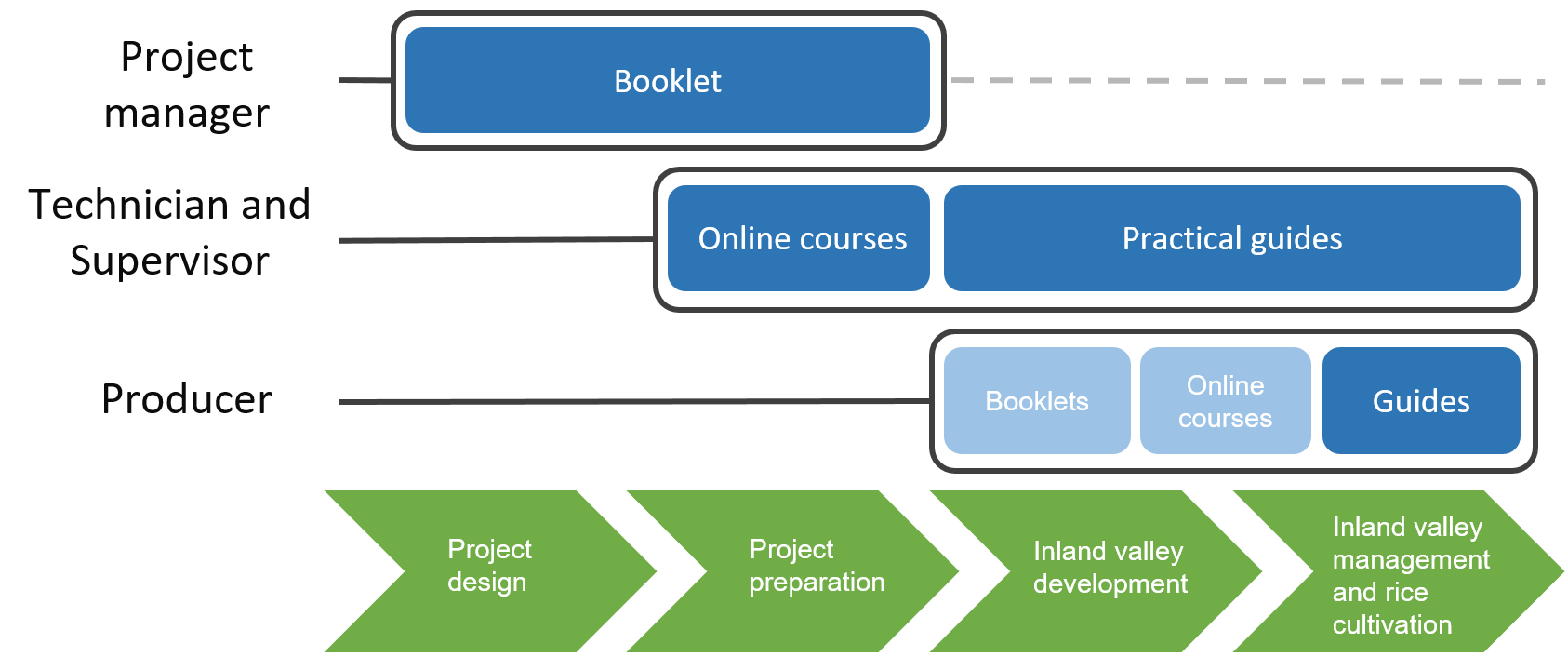The Smart-Valleys toolkit
Who is the toolkit for ?
The toolkit is a collection of tools: documents and e-learning courses, to support the dissemination and popularization of the Smart-Valleys inland valley development approach. It was created to help the various actors involved in the implementation of their tasks.
The toolkit is designed specifically for 3 groups of actors: project coordination, supervisors and technicians, and farmers. The main purpose of the toolkit is to train and support these players in their Smart-Valleys inland valley development project. It is also possible that some farmers wish to implement the Smart-Valleys approach or some of its components without the help of a project.
- The project coordination will find in the toolkit everything they need to plan, organize and coordinate the project. This includes project preparation, recruitment, training and monitoring of technicians and supervisors as well as the definition of work processes related to data collection and inland valley development activities.
- Technicians and supervisors will receive full training for the implementation of the Smart-valleys approach, as well as memory aids and field sheets to enable them to train farmers, and to carry out the project in the field.
- Farmers should implement the Smart-Valleys approach in the long term and if possible also disseminate it to their peers, so they can themselves use a large part of the toolkit to improve rice production in their inland valley. In addition to the work directly related to the inland valley development, they can develop their knowledge on the sustainable use of their inland valleys or the preservation of soil fertility.

The components of the toolkit
- Booklets provide detailed information on the subject. In addition to essential information, the user will also find additional information to better understand the subject and its context.
- Online courses allow the user to understand the topic and memorize the fundamental ideas and actions. The information is presented in a didactic way and learning is supported by interactive tests. The courses mainly help technicians to understand the different components of the Smart-valleys approach and the corresponding tasks. Once their training is completed, the technicians will pass this knowledge on to the farmers during the fieldwork.
- The practical guides are to be used during the implementation in the field. Only information essential for practical implementation is presented here, in a way that is easy to use in the field. These are either instructions with technical data or guidelines on how the activity should be carried out. These guides are mainly intended for technicians but can also be used by farmers who wish to improve their production on their own.
The following illustration suggests which type of tool is intended for which actor and at which stage of the project:

List of tools
Here is the list of tools by category, with a link to open each tool. The booklets and guides are in PDF format and can be downloaded and then printed if desired.
The e-learning courses are accessible on the Afrique-learning e-learning platform where a login is required:
- To study the courses in the best conditions, obtain your personal login either from AfricaRice or from Afrique-learning by sending your first name, last name and email address to info@afrique-learning.com (specify that you wish to access the Smart-Valleys toolkit)
- For a superficial view on the courses, without personalizing your studies, you can use this common login:
- Username = africa.rice
- Password = Africarice@2020
Booklets
For the design and management of a project
- Booklet 1 – Introduction to the Smart-Valleys toolbox
- Booklet 2 – Organization of an agricultural inland valley development project
- Booklet 3 – Gender and rice production
- Booklet 4 – Concept of the “service” to implement a project
- Booklet 5 - Collection, entry and verification of data (I-IV)
- Booklet 5-I - Tasks for collection, digitization and verification
- Booklet 5-II - The data collection and management application
- Booklet 5-III - Shared document management system
- Booklet 5-IV - Use of a spreadsheet for data entry or collection
- Booklet 6 - Soil fertility and fertilizers
- Booklet 7 - Sustainable agricultural use of inland valleys
Online courses
or training in self-management
- Course 1 – Gender and rice production
- Course 2 – Concept of "service" and how to perform a service
- Course 3 – Data collection, entry and verification
- Course 4 – Inland valley development for rice cultivation: the Smart-Valleys approach
- Course 5 – Inland valley selection for Smart-Valleys development
- Course 6 - Selection criteria for an inland valley for the Smart-Valleys approach approach
- Course 7 - Site visit & development plan of an inland valley
- Course 8 – Implementation of the development plan on the land
- Course 9 – Building of water control structures
- Course 10 – Management of the developed inland valley
- Course 11 - Soil fertility and fertilizers
- Course 12 - Sustainable agricultural use of inland valleys
The practical guides
Technical supports for practical work
- Guide 1 – Presentation of services for the selection and development of a lowland
- Guide 2 – Data sheets for the Smart-Valley approach
- Guide 3 – Data sheet checklist
- Guide 4 – Introduction and sensitization on Smart-Valleys approach
- Guide 5 – Field visit & development plan
- Guide 6 - Situating the development plan on the land: staking
- Guide 7 - Building water control structures
- Guide 8 - Lowland selection for Smart-Valleys development
- Guide 9 - Evaluation of selection criteria
- Guide 10 - Management of the developed lowland
- Guide 11 - Soil Fertility and Fertilizers
- Guide 12 - Sustainable use of lowlands